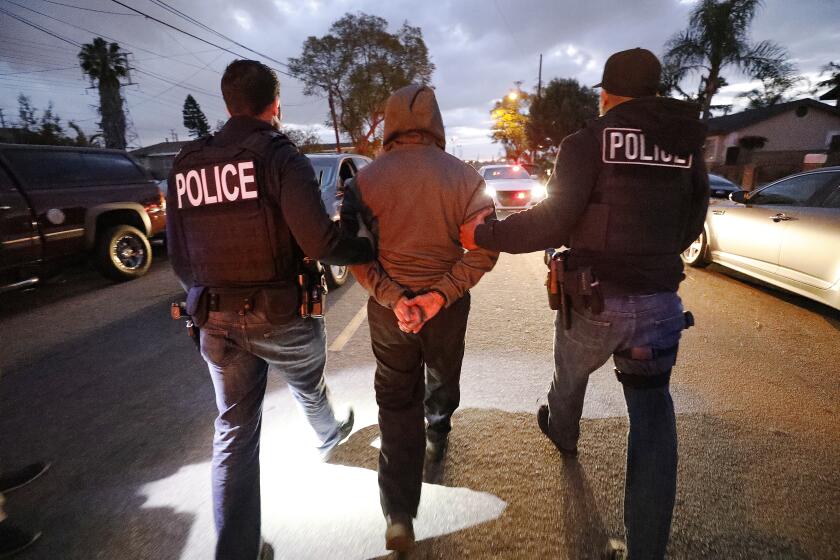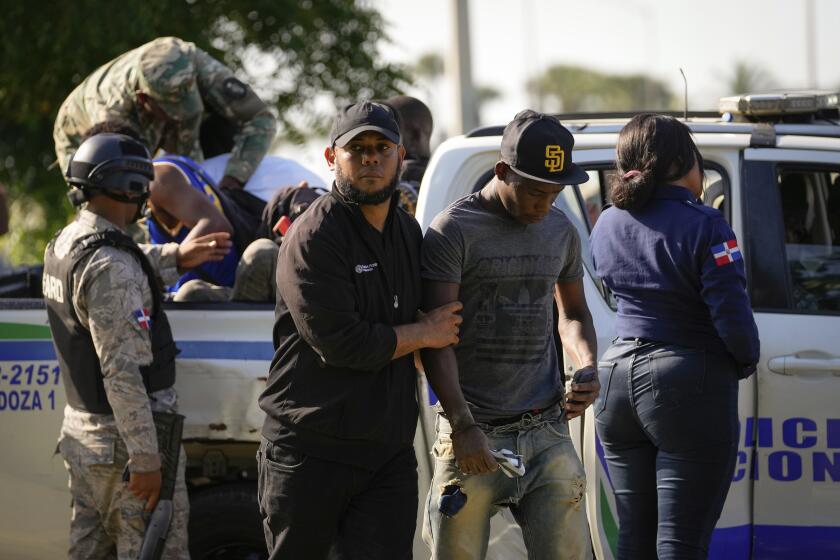Wider INS Targeting of Jails Urged
Nearly a year after federal agents launched a screening program to root out illegal immigrants in the Ventura County Jail, an effort is underway to expand the program nationwide.
The pilot program sponsored by Rep. Elton Gallegly (R-Simi Valley) has proved so effective that the congressman will argue before the House of Representatives today to expand it to 100 other counties across the country.
The screening revealed that about 1 in 10 inmates in the Ventura County Jail is in the country illegally or has committed a crime that calls for deportation.
During the first 11 months of the jailhouse screening effort, agents interviewed 1,648 inmates and put immigration holds on 943 of them, the first step toward deporting the inmates once they serve their time.
Of those, 847 inmates were illegal immigrants booked for offenses ranging from shoplifting to murder, although INS officials said they did not have an exact breakdown of the crimes committed by illegal immigrants during that period.
INS officials said most of those immigrants eventually will be formally deported, a move that sets them up for felony prosecution if they return to the United States.
“I think it has been a tremendous success,” said Kevin Jeffery, who heads the criminal alien section of the Immigration and Naturalization Service in Los Angeles. “I think a lot of people are simply surprised by the numbers. And certainly if we had not been there, these people would have done their county time and been released right back into the community.”
INS officers routinely visit county jails in Los Angeles, Orange, Riverside, San Bernardino, Santa Barbara and San Diego counties. But only Ventura County and the Anaheim City Jail have officers permanently assigned to monitor the immigration status of those arrested.
*
In Ventura County, INS agents identified Jose Zavala, a suspected serial rapist accused of terrorizing women in Thousand Oaks, as an illegal immigrant after his arrest earlier this year. Zavala, however, was previously deported to Mexico in 1994 after his conviction on misdemeanor charges and again in 1996 after a drug arrest.
Others identified through the screening program included Emilio Orosco, awaiting trial on suspicion of shooting at two Ventura County sheriff’s deputies during an April traffic stop. One deputy was seriously wounded.
Agents also identified Felix Mendez Magana as an illegal immigrant after he was convicted in the 1996 slaying of Santa Paula restaurant owner Isabel Guzman. Magana had two previous arrests for assault with a deadly weapon, authorities said.
“The man convicted of murdering Mrs. Guzman at her Santa Paula restaurant had been arrested three or four times,” Gallegly said. “He was a professional bad guy, but no one ever checked his immigration status.”
Two INS agents have been assigned to the jail since November 1996, seeking to identify illegal immigrants before they go to court and tagging them for deportation once they serve their sentences.
The agents use a variety of criteria in deciding who to interview, including whether inmates are identified as foreign-born nationals upon arrest or as they are booked into jail.
INS officials have no comprehensive breakdown of the kinds of crimes being committed by illegal immigrants. They do say, however, that during the program’s first six months about 10% of those screened were arrested for violent felonies and a third were picked up on drug charges.
The system is not foolproof. INS agents work the main jail just five days a week, eight hours a day.
Earlier this year, Ventura County Undersheriff Richard Bryce told a congressional subcommittee that there are still plenty of times, especially after hours and on weekends, when the INS extends no coverage to the jail.
“This has allowed many criminal aliens to continue to slip through the system without being identified,” said Bryce, urging legislators to expand the program. “Criminals don’t just operate during business hours, neither should this program.”
*
Some critics worry, however, that such jailhouse examinations infringe on the civil rights of those arrested. And there is an added concern that the INS may be casting its net too broadly.
INS officials said of the 1,648 inmates interviewed since the program started, 134 were U.S. citizens and 640 were legal immigrants.
As part of the program, dozens of legal immigrants also have been set up for deportation for committing crimes of “moral turpitude.” “My problem with this is that they’re probably painting with too broad a brush,” said attorney Oscar Gonzalez, a spokesman for the Ventura County Mexican American Bar Assn.
“If the purpose of this program is to tag illegal immigrants and send them back home, then it seems that they have washed over that line,” Gonzalez added. “The pool that is being selected for questioning is too broad. And if we are going to start lumping legal and illegal immigrants together, then I think we should have some debate about that and understand what the public has to say about it.”
Across Southern California, nearly 11,000 jailed illegal immigrants were identified for formal deportation during the six-month period ending March 31, INS officials said.
“Our main issue before this program came online is that we couldn’t track these people and so they would simply be released from jail after serving their time,” said Ventura County Sheriff’s Cmdr. Mark Ball. “Our issue isn’t deporting illegal immigrants, but we do feel that criminal aliens should be deported and prevented from committing crimes again in this county.”
More to Read
Start your day right
Sign up for Essential California for news, features and recommendations from the L.A. Times and beyond in your inbox six days a week.
You may occasionally receive promotional content from the Los Angeles Times.






